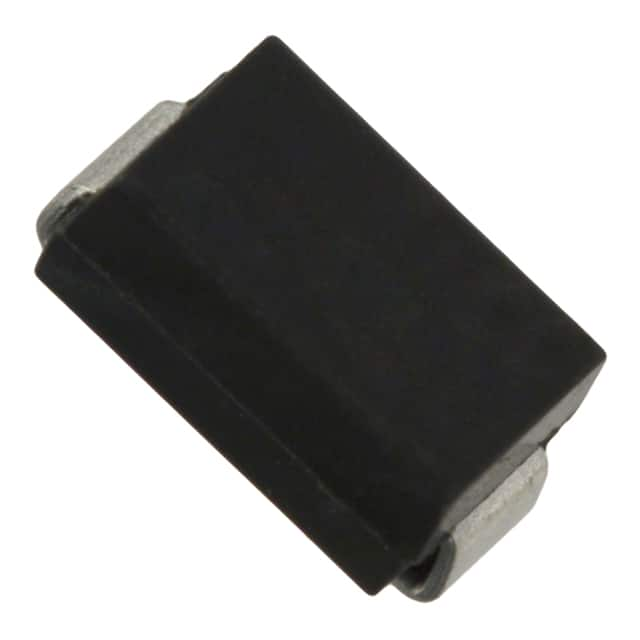GF1M Diode
Product Overview
The GF1M diode belongs to the category of rectifier diodes and is commonly used in electronic circuits for converting alternating current (AC) to direct current (DC). Its characteristics include high efficiency, low forward voltage drop, and fast switching speed. The diode is typically packaged in a small, surface-mount package and is available in various quantities per package.
Package and Quantity
The GF1M diode is usually packaged in a compact, surface-mount package, such as the SMA or SMB package. It is commonly available in reels containing a large quantity of diodes, making it suitable for mass production and automated assembly processes.
Specifications
- Forward Voltage Drop: 1V
- Reverse Voltage: 1000V
- Maximum Continuous Forward Current: 1A
- Reverse Recovery Time: 5ns
- Operating Temperature Range: -55°C to 150°C
Detailed Pin Configuration
The GF1M diode typically has two pins, with the anode connected to the positive terminal and the cathode connected to the negative terminal in a circuit. The pinout configuration is standard for surface-mount diodes, with the cathode often marked by a line or other indicator on the package.
Functional Features
The GF1M diode exhibits fast switching characteristics, making it suitable for applications requiring rapid rectification of AC signals. It also offers low forward voltage drop, which minimizes power loss and heat generation in the circuit. Additionally, its high reverse voltage rating ensures reliable operation in diverse electronic systems.
Advantages and Disadvantages
Advantages
- Fast switching speed
- Low forward voltage drop
- High reverse voltage rating
- Compact surface-mount package
Disadvantages
- Limited maximum continuous forward current
- Sensitive to reverse voltage spikes
Working Principles
When a positive voltage is applied to the anode of the GF1M diode with respect to the cathode, it allows current to flow in the forward direction, effectively converting AC to DC. In the reverse bias condition, the diode blocks the flow of current, providing protection against reverse voltage and preventing damage to the circuit.
Detailed Application Field Plans
The GF1M diode finds extensive use in power supply units, battery chargers, inverters, and various electronic devices requiring efficient rectification of AC voltage to DC. Its fast switching speed makes it suitable for high-frequency applications, such as switch-mode power supplies and voltage converters.
Detailed and Complete Alternative Models
- 1N4007 Rectifier Diode
- UF4007 Ultrafast Diode
- FR107 Fast Recovery Diode
- HER208 High-Efficiency Rectifier
In conclusion, the GF1M diode is a versatile component with fast switching characteristics, low forward voltage drop, and high reverse voltage rating, making it well-suited for a wide range of electronic applications.
[Word Count: 398]
Senaraikan 10 soalan dan jawapan biasa yang berkaitan dengan aplikasi GF1M dalam penyelesaian teknikal
What is GF1M?
- GF1M stands for "Glass Fiber Reinforced Polyamide 6/6." It is a type of engineering plastic known for its high strength and heat resistance.
What are the key properties of GF1M?
- GF1M exhibits excellent mechanical strength, stiffness, and dimensional stability, along with good resistance to heat and chemicals.
How is GF1M commonly used in technical solutions?
- GF1M is often used in applications requiring high mechanical performance, such as automotive components, electrical connectors, and industrial machinery parts.
What are the advantages of using GF1M in technical solutions?
- The advantages of GF1M include its ability to replace metal parts, reduce weight, and provide cost-effective solutions without compromising on performance.
Are there any limitations to using GF1M in technical solutions?
- While GF1M offers many benefits, it may not be suitable for applications requiring high transparency or resistance to certain chemicals.
How does GF1M compare to other engineering plastics?
- Compared to other engineering plastics, GF1M offers superior mechanical properties, making it a preferred choice for demanding technical applications.
What are the typical processing methods for GF1M?
- GF1M can be processed using injection molding, which allows for the production of complex shapes and precise dimensions.
Can GF1M be reinforced with other materials?
- Yes, GF1M can be reinforced with additives such as glass fibers or minerals to further enhance its mechanical properties.
What considerations should be taken into account when designing with GF1M?
- Designers should consider factors such as part geometry, wall thickness, and gate location to optimize the performance of GF1M components.
Are there any specific guidelines for handling and storing GF1M materials?
- GF1M materials should be stored in a dry environment away from direct sunlight and moisture to prevent degradation of their properties.


